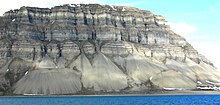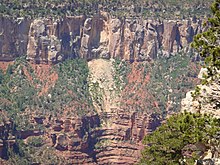
Back فقدان كتلي Arabic Mas-symudiad Welsh Massenbewegung (Geologie) German Deklivglitado Esperanto Remoción de masa Spanish حرکت تودهای Persian Instabilité gravitaire French תנועת בלית HE Pemborosan massal ID マスムーブメント Japanese



Mass wasting, also known as mass movement,[1] is a general term for the movement of rock or soil down slopes under the force of gravity. It differs from other processes of erosion in that the debris transported by mass wasting is not entrained in a moving medium, such as water, wind, or ice. Types of mass wasting include creep, solifluction, rockfalls, debris flows, and landslides, each with its own characteristic features, and taking place over timescales from seconds to hundreds of years. Mass wasting occurs on both terrestrial and submarine slopes, and has been observed on Earth, Mars, Venus, Jupiter's moon Io, and on many other bodies in the Solar System.
Subsidence is sometimes regarded as a form of mass wasting. A distinction is then made between mass wasting by subsidence, which involves little horizontal movement, and mass wasting by slope movement.
Rapid mass wasting events, such as landslides, can be deadly and destructive. More gradual mass wasting, such as soil creep, poses challenges to civil engineering, as creep can deform roadways and structures and break pipelines. Mitigation methods include slope stabilization, construction of walls, catchment dams, or other structures to contain rockfall or debris flows, afforestation, or improved drainage of source areas.
- ^ Allaby, Michael (2013). "mass movement". A dictionary of geology and earth sciences (Fourth ed.). Oxford: Oxford University Press. ISBN 9780199653065.